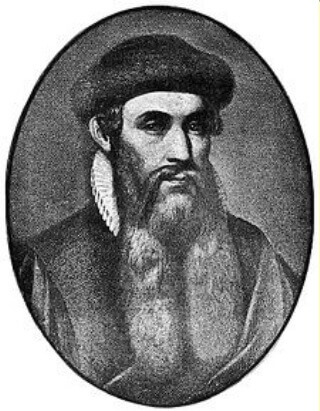
Johann Gutenberg, a German goldsmith and printer, is credited with being the first European to use movable type printing. In 1439, he became the global inventor of the mechanical printing press. He also produced the Gutenberg Bible.
1. Movable Type Printing
Gutenberg is given credit for inventing the first press capable of mass-producing movable type using oil-based ink on wooden printing presses. Gutenberg came up with a printing system that was unique. The process of moveable type printing was actually more complicated than even early historians believed. However complicated, it was a vast improvement over handwriting manuscripts, as was done prior to the invention of the press. European bookmaking was revolutionized and printing innovations would spread rapidly throughout Europe.
2. Honors and Awards
Gutenberg remains a pivotal figure in world history whose inventions have changed the world. In 1999, the A&E Network ranked Gutenberg #1 on their “People of the Millennium” countdown. In 1997, Time-Life magazine picked Gutenberg’s printing press as the most important invention of the second millennium.
3. Being Sued
Gutenberg was not a wealthy man nor did he have a steady source of income, so he borrowed the money that he needed to come up with his press. Gutenberg used borrowed funds for the printing of his Bible project. Gutenberg was sued by his lender and ended up virtually bankrupt. The man who sued Gutenberg then became the first European shop to print their name on the books that they made with the press.
4. Exiled
Gutenberg was exiled after having a heated argument with two archbishops. While living in exile, he supervised the building of a new printing press belonging to the brothers Bechtermünze. He also worked on printing some books of his own though how many were his own is unknown because he did not always include his name on the book.
5. A New Title
In January 1465, Gutenberg’s achievements were recognized and he was given the title Hofmann (gentleman of the court) by von Nassau. With this honor came some benefits. As a gentleman of the court, he was awarded a stipend which he used to support himself and to travel.
6. Attention to Detail
Gutenberg paid close attention to detail when using his press, especially when it came to the printing of his Bibles. His Bibles were so beautifully created that they sold for an amount that equaled roughly three years’ wages for an average clerk.
7. How The Press Worked
Gutenberg’s press worked by first hammering a hard metal punch (with the letter carved back to front) into soft metal copper. This makes what is called a mold or matrix. This is then placed into a holder, and cast by filling the mold with hot metal, which cooled down to create a piece of type. The matrix can now be reused to create hundreds of identical letters. Because the letters can be used in any combination the type is called moveable.
8. Other Hypothesis About The Press’ Origins
Historians have examined papers that were said to have been copied on a Gutenberg press to determine if, in fact, Gutenberg was using the materials that history tells us that he used. There have been some disagreements regarding their findings and therefore there are those who claim that Gutenberg could not have been the inventor of moveable type printing or it would have been used in specific methods on certain documents including his own Gutenberg Bible.
9. Financially Unsuccessful in His Lifetime
Although Gutenberg was never monetarily rewarded for his innovations during his lifetime, the invention of his press was a huge contributor to the Renaissance and a catalyst for the scientific revolution. Printing technologies allowed for news and books to travel across Europe much faster than before.
10. Gutenberg’s Historical Impact
Without Gutenberg’s press, Christopher Columbus would not have had the geographical book (printed by movable types) that inspired him to explore, Martin Luther would not have had his 95 Thesis circulated and broadsheet news would never have evolved in to newspapers, the first form of mass media publishing.

Just got this sweet note from a teacher, and wanted to share! BJF
………………………….
Hi There,
I came across your page (http://www.biographycentral.net/johann-gutenberg.php) while searching for resources with my students. We are studying inventions of The Renaissance and found your resources very helpful. We used them during class, hope you don’t mind! Just wanted to send a quick thanks for the great info! 🙂
My students suggested that I pass along another article they came across during their class searches. http://www.overnightprints.com/history_of_printing
Would you be willing to add this article to your page? I know they would be thrilled to see their recommendation up on your page and I told them I would do my best! haha 🙂
Sincerely,
Linda Fuller
very amusing and strange like the tides